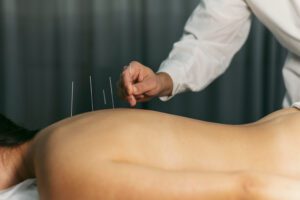Acupuncture has been used for thousands of years to treat a wide range of health conditions, from chronic pain to insomnia. Despite its long history and proven effectiveness, there are still many myths and misconceptions about acupuncture that persist today.
In this blog post, we’ll debunk five of the most common myths about acupuncture and provide the facts to help you better understand this ancient practice.

Myth #1: Acupuncture is painful
One of the biggest myths about acupuncture is that it is a painful and uncomfortable procedure. However, most people who have had acupuncture describe the sensation as a dull ache or a tingling sensation, rather than a sharp pain. The needles used in acupuncture are extremely thin, about the width of a human hair, and are inserted into the skin at a depth of only a few millimeters.
Fact:
Acupuncture is generally painless and well-tolerated by most people. We only use sterile, one-time use, patient friendly needles.
Myth #2: Acupuncture is not evidence-based
Some people believe that acupuncture is not based on scientific evidence and is therefore not a valid form of medical treatment. However, there is a growing body of research that supports the effectiveness of acupuncture for a wide range of health conditions.
In fact, the World Health Organization (WHO) recognizes acupuncture as a safe and effective treatment for a variety of conditions, including chronic pain, headaches, nausea and vomiting, anxiety, depression, and infertility.
Fact:
Acupuncture is backed by scientific evidence and recognized by the World Health Organization as a safe and effective treatment for many health conditions.
Myth #3: Acupuncture is only effective as a placebo
Another common myth about acupuncture is that its effectiveness is due to the placebo effect, rather than any specific therapeutic benefit. While it is true that the placebo effect can play a role in the effectiveness of any medical treatment, there is ample evidence to suggest that acupuncture has specific physiological effects that go beyond the placebo effect.
For example
studies have shown that acupuncture can stimulate the release of endorphins, the body’s natural painkillers, and regulate the activity of the autonomic nervous system, which controls many of the body’s involuntary functions.
Fact:
Acupuncture has specific physiological effects that go beyond the placebo effect.
Myth #4: Acupuncture is only for treating pain
While acupuncture is best known for its ability to relieve pain, it can be used to treat a wide range of health conditions. In addition to chronic pain, acupuncture has been shown to be effective in treating conditions such as migraines, insomnia, anxiety and depression, digestive disorders, and even infertility.
Acupuncture works by stimulating the body’s natural healing processes, which can improve overall health and well-being. By targeting specific points in the body, acupuncture can help to balance the body’s energy and promote optimal health.
Fact:
Acupuncture can be used to treat a wide range of health conditions, not just pain.
Myth #5: Acupuncture is not safe
Some people are concerned about the safety of acupuncture, particularly the risk of infection or injury from needles. However, when performed by a licensed and experienced acupuncturist, acupuncture is a safe and low-risk procedure.
In fact, the needles used in acupuncture are sterile and disposable and are never reused. Acupuncturists are also trained to follow strict safety protocols to ensure the well-being of their patients.
Fact:
Acupuncture is a safe and low-risk procedure when performed by a licensed and experienced acupuncturist.
Acupuncture is a safe and effective form of traditional Chinese medicine that can help to improve a wide range of health conditions. By debunking these common myths about acupuncture, we hope to help you better understand this ancient practice and the benefits it provides. Contact me in Markham to learn more about how acupuncture can help you.
Extended health services can be claimed under naturopathic medicine and/or acupuncture, and you may be able to have your services billed directly.
Sources
“Acupuncture: A Review of Its Uses and Potential Benefits” by E. Ernst and M. S. Lee, in The American Journal of Medicine (2011).
https://www.amjmed.com/article/S0002-9343(10)00828-8/fulltext
“Acupuncture Mechanisms: An Updated Overview of Scientific Evidence” by T. Cheng and H. Lin, in Journal of Acupuncture and Meridian Studies (2014).
https://www.sciencedirect.com/science/article/pii/S2005290114001201
“Acupuncture for Chronic Pain: Update of an Individual Patient Data Meta-Analysis” by A. Vickers, et al., in The Journal of Pain (2018).
https://www.jpain.org/article/S1526-5900(18)30068-X/fulltext
“Acupuncture for the Treatment of Insomnia: A Systematic Review of Randomized Controlled Trials” by J. Cao, et al., in Journal of Alternative and Complementary Medicine (2009).
“Safety of Acupuncture: Results of a Prospective Observational Study with 229,230 Patients and Introduction of a Medical Information and Consent Form” by T. Melchart, et al., in Forschende Komplementarmedizin und klassische Naturheilkunde (2004).
